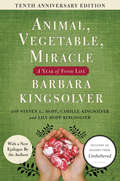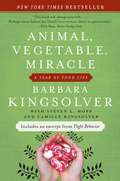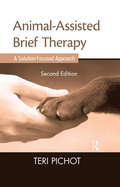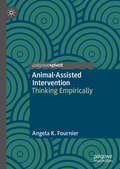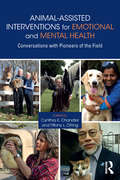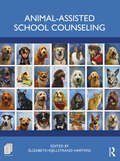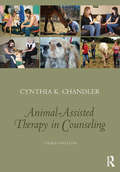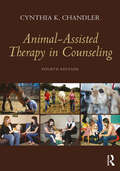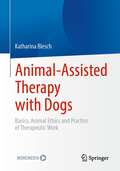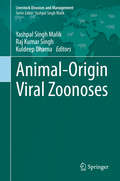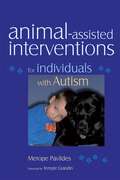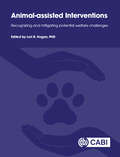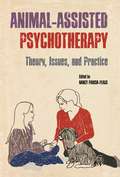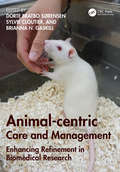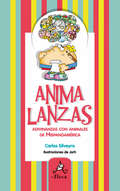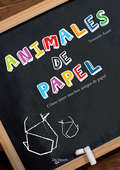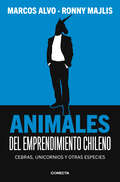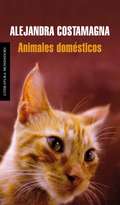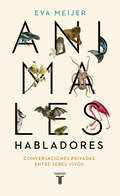- Table View
- List View
Animal, Vegetable, Miracle - 10th anniversary edition: A Year of Food Life
by Barbara Kingsolver Steven L. Hopp Camille Kingsolver Lily Hopp Kingsolver“A profound, graceful, and literary work of philosophy and economics, well tempered for our times, and yet timeless. . . . It will change the way you look at the food you put into your body. Which is to say, it can change who you are.” — Boston GlobeA 10th anniversary edition of Barbara Kingsolver's New York Times bestseller that describes her family's adventure as they move to a farm in southern Appalachia and realign their lives with the local food chainSince its publication in 2007, Animal, Vegetable, Miracle has captivated readers with its blend of memoir and journalistic investigation. Updated with original pieces from the entire Kingsolver clan, this commemorative edition explores how the family's original project has been carried forward through the years.When Barbara Kingsolver and her family moved from suburban Arizona to rural Appalachia, they took on a new challenge: to spend a year on a locally-produced diet, paying close attention to the provenance of all they consume. Concerned about the environmental, social, and physical costs of American food culture, they hoped to recover what Barbara considers our nation's lost appreciation for farms and the natural processes of food production. Since 2007, their scheme has evolved enormously. In this anniversary edition, featuring an afterword by the entire Kingsolver family, Barbara's husband, Steven, discusses how the project grew into a farm-to-table restaurant and community development project training young farmers in their area to move into sustainable food production. Camille writes about her decision to move back to a rural area after college, and how she and her husband incorporate their food values in their lives as they begin their new family. Lily, Barbara's youngest daughter, writes about how growing up on a farm, in touch with natural processes and food chains, has shaped her life as a future environmental scientist. And Barbara writes about their sheep, and how they grew into her second vocation as a fiber artist, and reports on the enormous response they've received from other home-growers and local-food devotees.With Americans' ever-growing concern over an agricultural establishment that negatively affects our health and environment, Animal, Vegetable, Miracle is a modern classic that will endure for years to come.
Animal, Vegetable, Miracle: A Year of Food Life
by Barbara Kingsolver Steven L. Hopp Camille KingsolverBestselling author Barbara Kingsolver returns with her first nonfiction narrative that will open your eyes in a hundred new ways to an old truth: You are what you eat. "As the U.S. population made an unprecedented mad dash for the Sun Belt, one carload of us paddled against the tide, heading for the Promised Land where water falls from the sky and green stuff grows all around. We were about to begin the adventure of realigning our lives with our food chain. "Naturally, our first stop was to buy junk food and fossil fuel. . . ." Hang on for the ride: With characteristic poetry and pluck, Barbara Kingsolver and her family sweep readers along on their journey away from the industrial-food pipeline to a rural life in which they vow to buy only food raised in their own neighborhood, grow it themselves, or learn to live without it. Their good-humored search yields surprising discoveries about turkey sex life and overly zealous zucchini plants, en route to a food culture that's better for the neighborhood and also better on the table. Part memoir, part journalistic investigation, Animal, Vegetable, Miracle makes a passionate case for putting the kitchen back at the center of family life and diversified farms at the center of the American diet. "This is the story of a year in which we made every attempt to feed ourselves animals and vegetables whose provenance we really knew . . . and of how our family was changed by our first year of deliberately eating food produced from the same place where we worked, went to school, loved our neighbors, drank the water, and breathed the air."
Animal-Assisted Brief Therapy: A Solution-Focused Approach
by Teri PichotThis book provides an overview of Animal-Assisted Activities (AAA) and Animal-Assisted Therapy (AAT) and demonstrates how they can be incorporated into solution-focused treatment programs. Pichot, focusing on the use of therapy dogs, starts with a discussion of the basics of AAA/T and solution-focused therapy, as well as what every practitioner should know about dogs before partnering with them. Successfully combining all of this into an effective treatment program is considered next. Pichot draws upon her own experience developing an AAA/T program in the substance abuse counseling program at a county public health agency to illustrate the effective implementation of such a program and the struggles and lessons learned in doing so. Using AAA/T with special populations, cultural considerations, and the impact a therapy dog can have on the handler. New in this edition are client scenarios that demonstrate the therapist’s thought process when making clinical decisions about when and how to use a therapy dog. Sample forms and treatment plans are also provided that professionals can use to modify or structure in their work with clients. The concepts and information provided in this valuable guide will be helpful for any therapist regardless of whether he or she is in private practice or working in an agency setting.
Animal-Assisted Intervention: Thinking Empirically
by Angela K. FournierThis book brings the animal into the scholarly discussion of animal-assisted therapy and other interventions. Challenging the current reliance on outcome studies, the author offers a new way of thinking empirically about animal-assisted interventions—analysis of human-animal interaction as a critical component. Through empirical demonstrations from laboratory and applied settings, the book encourages practitioners and scholars to undergo a deeper examination of the basic interactions that occur between clients or patients and therapy animals. Dr. Fournier provides new ideas on measurement, experimentation, and interpretation of human-animal interaction, aimed at identifying the role of the animal in interventions for human health and well-being.
Animal-Assisted Interventions for Emotional and Mental Health: Conversations with Pioneers of the Field
by Cynthia K. Chandler and Tiffany L. OttingAnimal-Assisted Interventions for Emotional and Mental Health provides a unique opportunity to learn from a variety of leaders in the field. Leading scholar Dr. Cynthia Chandler and colleague Dr. Tiffany Otting present interviews with pioneering experts from the U.S., U.K., Israel, India, and Hong Kong, revealing key beliefs, values, and ideas that are fundamental to animal-assisted interventions. Their words will inspire and guide current and future generations of practitioners, teachers, and researchers.
Animal-Assisted School Counseling
by Elizabeth Kjellstrand HartwigAnimal-Assisted School Counseling (AASC) is a hands-on resource that provides invaluable information for school counselors interested in partnering with a therapy animal on campus to help students meet social and emotional goals. This book presents a wealth of resources for school counselors and school-based mental health practitioners to incorporate animal partners on school campuses with individual students and groups and in classroom and schoolwide settings. Using the American School Counselor Association (ASCA)National Model framework, this book presents AASC interventions that can be implemented as part of the multitiered system of support to address students’ mental health needs. The text also meets the important demand for accountability in school counseling by providing resources for assessing the effectiveness of AASC interventions for meeting student and school outcome goals. Addressing such issues as getting school district buy-in, choosing an animal partner, preparing the school for an animal partner, theoretical applications of AASC, and student-affirming AASC services, the book is organized such that each chapter builds upon the next so school counselors understand what steps to take to become an effective AASC team. Ideal for the school counselor, social worker, or psychologist who may not have specific training in AASC, this book will encourage school mental health practitioners to seek out training programs to become an AASC team.
Animal-Assisted Therapy in Counseling
by Cynthia K. ChandlerThe third edition of Animal-Assisted Therapy in Counseling is the most comprehensive book available dedicated to training mental health practitioners in the performance of animal assisted therapy in counseling (AAT-C). New to this edition is discussion of the human-animal relational theory, a new theory dedicated to the practice of AAT-C. This edition also has added applications for supervision and includes the most recent research and practice. Consistent with previous editions, a variety of animal-assisted interventions are described with case examples provided in a variety of settings with different types of animals. This unique resource is an indispensable guide for any counselor or psychotherapist looking to develop and implement AAT techniques in practice.
Animal-Assisted Therapy in Counseling
by Cynthia K. ChandlerThe fourth edition of Animal-Assisted Therapy in Counseling is the most comprehensive book available dedicated to training mental health practitioners in the performance of animal-assisted therapy in counseling.This edition includes material on real-world animal-assisted interventions featuring counselor-client dialogues and sample therapeutic opportunities. Each chapter includes the most recent research and practice, and a wide variety of case examples present animal-assisted interventions in different settings with different types of animals.This unique resource is an indispensable guide for any counselor or psychotherapist looking to develop and implement animal-assisted therapy techniques in practice.
Animal-Assisted Therapy with Dogs: Basics, Animal Ethics and Practice of Therapeutic Work
by Katharina BleschAnimal-assisted therapy has been the talk of the town for several years and is increasingly being integrated into the psychotherapeutic treatment of people. But how exactly can dogs support psychotherapeutic work? How can animal welfare and human welfare be combined? Which dogs are suitable and how are they prepared? This book provides a practical and lively insight into therapeutic work with dogs. In addition to an overview of the basics as well as animal welfare and ethical aspects of dog-assisted therapy, concrete exercises in the context of dog-assisted self-confidence training are described pictorially and by video, providing inspiration for therapeutic work in various institutions and situations.
Animal-Origin Viral Zoonoses (Livestock Diseases and Management)
by Kuldeep Dhama Yashpal Singh Malik Raj Kumar SinghThis book is the second volume in the series Livestock Diseases and Management, and reviews the importance and implications of animal origin viral zoonoses. It also highlights the specific etiology and epidemiology of these viral infections and discusses their various biological and mechanical transmission mechanisms. Further, the book reviews various measures for controlling viral zoonoses and examines novel therapeutic and prophylactic strategies.Discussing recent studies on the pathogenesis and host immune response to these infections, it underscores the importance of using vaccines against these viral diseases to reduce the risk of them being transmitted to humans.Lastly, it describes in detail the challenges posed by these viral infections and our readiness to face them.
Animal-assisted Interventions for Individuals with Autism
by Temple Grandin Merope PavlidesThis book looks at how therapies involving animals can be used to help individuals with autism to develop skills, including sensory and social skills, to manage challenging behaviors, and improve quality of life. Whether participating in therapeutic horseback riding, utilizing a trained service dog, visiting a dolphin therapy center, or simply experiencing companion animal therapy, people with autism can reap a multitude of benefits from interaction with furry, feathered, and finned friends. Merope Pavlides relates the success stories of different animal-assisted interventions, as well as noting the challenges of working with particular animal species. She also emphasizes the importance of tailoring interventions to the specific needs of the individual and of monitoring progress. With recommendations for resources and further reading, this book will be of great interest to people with autism, their parents, and the professionals who work with them.
Animal-assisted Interventions: Recognizing and Mitigating Potential Welfare Challenges
by Temple Grandin Helen Lewis Amy Johnson Susan D. Greenbaum Ashley Thompson Aubrey H. Fine Veronica Lac Patti Anderson Nicky Barendrecht-Jenken Anna Van Berg Darlene Blackman Eileen Bona Donna Clarke Linda Chassman Craddock Yvonne Eaton-Stull Cynnie Foss Angela Fournier Megan French Nina Ekholm Fry Lisa-Maria Glenk Taylor Chastain Griffin Joy R. Hanson Terri Hlava Ann R. Howie Batya Gugenheim Jaffe Suzanne M. Kapral Jean Kirnan Ursula A. Kohl Elizabeth A. Letson Kirsty MacQueen Arieahn Matamonasa-Bennett Angela M. Moe Julie Ann Nettifee Zenithson Ng Brittany Panus Caiti Peters Laura Poleshuck Missy Reed Elizabeth Ruegg Brenda Rynders Sarah Schlote Shira Smilovici Risë VanFleet Melissa Y. Winkle Katrina WinsorThis is a practical book exploring how to conduct animal assisted intervention (AAI) in ways that protect and prioritize animal and human welfare. This resource is for social scientists (e.g., psychology, social work, human development and family studies, etc.), as well as ethologists and animal behaviour and welfare students and practitioners. The book is a series of short chapters that depict a wide array of AAIs and their potential welfare concerns. The chapters include descriptions of the AAI offered, the welfare challenges, and ways to successfully mitigate these challenges. This book also covers critical topics including therapy animals' aging, retirement, and death as well as ethical issues including animal consent. Species include not only dogs, but horses, rabbits, and other small animals (e.g., guinea pigs, mice, etc.). Types of AAI involve individual interventions as well as crisis dogs (those who help after natural and man-made disasters), and residential animals. The book is designed to be a practical, engaging book with links to video and examples of real-life situations. It is evidence-based, yet user-friendly and directly applicable to students and practitioners. This highly practical and engaging book with examples of real life situations, videos and case studies, explores how to conduct animal assisted interventions in ways that protect and prioritize animal and human welfare. The book: · Explores how to conduct animal assisted intervention (AAI) in ways that protect and prioritize animal and human welfare. · Discusses potential welfare challenges including how to advocate for the animal, animal consent, and the animal's aging, retirement, or death. · Evidence based approach to mitigating welfare concerns for a wide range of therapy animals including dogs, horses, rabbits, rodents, and exotic animals - and their recipients. An invaluable resource for ethologists and animal behaviour and welfare students and practitioners, as well as social scientists (e.g., psychology, social work, human development and family studies).
Animal-assisted Psychotherapy: Theory, Issues, And Practice
by Nancy Parish-PlassThe integration of animals into the therapy setting by psychotherapists has been a growing trend. Psychological problems treated include emotional and behavioral problems, attachment issues, trauma, and developmental disorders. An influential 1970s survey suggests that over 20 percent of therapists in the psychotherapy division of the American Psychological Association incorporated animals into their treatment in some fashion. Anecdotal evidence suggests that the number is much higher today. Since Yeshiva University psychologist Boris Levinson popularized the involvement of animals in psychotherapy in the 1960s, Israel has come to be perhaps the most advanced country in the world in the area of animal-assisted psychotherapy (AAP). This is true especially in the areas of academic training programs, theory-building, and clinical practice. Great effort has been put into understanding the mechanisms behind AAP, as well as into developing ethical guidelines that take into account the therapist s responsibility toward both client and animal. This book exposes the world to the theory and practice of AAP as conceived and used in Israel. It emphasizes evidence-based and clinically sound applications with psychotherapeutic goals, as differentiated from other animal-assisted interventions, such as AAE (animal-assisted education) and AAA (animal-assisted activities), which may have education or skills-oriented goals. Not just anyone with a dog can call him-or herself an animal-assisted therapist. This volume demonstrates not only the promise of animal-assisted psychotherapeutic approaches, but also some of the challenges the field still needs to overcome to gain widespread legitimacy.
Animal-centric Care and Management: Enhancing Refinement in Biomedical Research
by Dorte Bratbo Sørensen, Sylvie Cloutier, and Brianna N. GaskillThe concept of the 3Rs (Refinement, Reduction and Replacement) has been used as a framework for improving the welfare of laboratory animals for the last half century. By establishing an animal-centric view on housing and management, Animal-centric Care and Management: Enhancing Refinement in Biomedical Research takes Russell and Burch’s definition of Refinement as "elimination of inhumanities" and goes further. Rather than fitting animals into experimental conditions, it encourages readers to adjust conditions to better meet the behavioral, emotional, physical, and physiological needs and preferences of the animals. The team of expert authors, from the fields of laboratory animal science, ethology, biology as well as animal training, provide ideas for creating housing conditions and handling procedures that induce, to the best of current abilities and knowledge, a long-term positive state of mind in the animals under our care. This book is written for animal caretakers, animal health technicians, researchers, animal facility managers, laboratory animal veterinarians, and anyone who engages in work with living experimental animals or is interested in the continuous improvement of laboratory animal welfare. This interdisciplinary guide will act as a catalyst, resulting in multiple viewpoints and fields collaborating to optimize laboratory animal welfare.
Animalanzas
by Carlos SilveyraAnimalanzas incluye casi doscientos acertijos de Hispanoamérica, ideales para leer y reir en los ratos libres. Animalanzas incluye casi doscientos acertijos de Hispanoamérica, ideales para leer y reir en los ratos libres.
Animales a bordo: Animals on Board (Spanish Edition) (MathStart 2)
by Stuart J. Murphy“Kids, young and old, fall in love with math when they see how real-life and effortless it becomes thanks to these books.” —Kimberly D. Mueller, Ed.D., First Grade Teacher, Ashbrook School, Lumberton NJThis high-quality Spanish-language book can be enjoyed by fluent Spanish speakers as well as those learning the language, whether at home or in a classroom.Sáobete al camián de Jill y su perro y suma junto con ellos los animales que ven pasar en el camino. Estos animales son muy especiales y van a un lugar que te sorprendera.The MathStart series has sold over 1.5 million copies and combines math with fun stories that have real-life applications. In Animales a bordo, a Level Two MathStart, simple addition equations help children to understand basic arithmetical operations.Math skills are life skills, and the MathStart series supports success!This award-winning series by Stuart J. Murphy teaches math through stories and visual models63 books divided into three levels with 21 books in eachFun activities kids will love are included to help parents and teachers emphasize the lessonsEngaging and relatable stories, with each story revolving around practical applications of the math concept presentedLively art from top-notch illustratorsCharts and other visual representations help children understand how the math works and promote deeper comprehensionMathStart's unique combination of stories, illustrations, and visual models helps teachers and parents in the teaching of math and provides all children with the opportunity to succeed.The math concepts taught in MathStart books conform to state and national standards. Level 1 is Pre-K–Kindergarten; Level 2 is Grades 1–3; Level 3 is Grades 2–4. The series follows math topics across grades so there is a foundational path to learning that runs through the levels.Help kids with their math skills plus their reading skills with the engaging and fun MathStart series!
Animales bebé (¡Arriba la Lectura! Level E #89)
by Heather HammondsNIMAC-sourced textbook <p><p> ¡Mira estos animales bebé! También puedes ver la mamá de cada uno y saber qué hacen juntos.
Animales con armadura (¡Arriba la Lectura!, Level O #57)
by Jill McDougallNIMAC-sourced textbook. Muchos animales tienen una armadura que los protege. Gracias a ella, es más difícil que se conviertan en presa de sus depredadores. Descubre los tipos de armadura: espinas, escamas, caparazón y exoesqueleto.
Animales con armadura para sobrevivir (¡Arriba la Lectura!, Level L #6)
by Stanford MakishiNIMAC-sourced textbook. Los animales silvestres tienen varias maneras de protegerse. ¿Qué tienen en común los puercoespines, las tortugas y los cocodrilos? Lee este libro para enterarte.
Animales de papel
by Emanuele AzzitàUna hoja de papel cualquiera en tus manos y el libro abierto; lee las instrucciones, mira los dibujos y dobla el papel, despacito y con cuidado... verás que, como por arte de magia, ¡la hoja de papel ha desaparecido y tienes ante ti un cisne! (o una rana o el animal que hayas elegido). Así de fácil y de divertida es la papiroflexia. Si practicas con frecuencia, lo harás cada vez mejor y, si además utilizas papeles de colores distintos o pintas tus obras con lápices de colores, pronto podrás tener los animales de tu propio zoo, de tu granja o de tu selva. La papiroflexia es una actividad muy fácil de practicar que, sin más gastos, procura grandes momentos de diversión, y que el padre y la madre podrán compartir con sus hijos e hijas. Ayuda a desarrollar la habilidad manual, la imaginación y la creatividad; mejora la autoestima de los niños y niñas que comprueban que son capaces de crear sus propios juguetes. Usted puede también enseñarles a reciclar el papel usado para sus juegos a la vez que los aleja de la televisión y otras pantallas electrónicas. Emanuele Azzità es un gran experto en papiroflexia que ha publicado varias obras sobre este tema en Editorial De Vecchi. En esta ocasión, se ha propuesto presentar graciosos proyectos, apropiados para los más jóvenes de la casa.
Animales del emprendimiento chileno: Cebras, Unicornios y otras especies
by Marcos Alvo Ronny MajlisHistorias de los más exitosos emprendimientos chilenos del último tiempo, ocupando la taxonomía animal para agruparlos con mucho humor. Cebras, unicornios, camellos, gacelas, cigüeñas y leones. La fauna chilena del emprendimiento es tan amplia como diversa. Los unicornios, la especie de moda, se han convertido en verdaderas estrellas de rock: algunos de sus especímenes, como los fundadores de NotCo y Cornershop, cuyas empresas están avaluadas en más de mil millones de dólares, son retratados por los medios de comunicación como el mejor ejemplo del Chilean Dream. Pero este título no se encarga solo de los animales de moda, sino también de otras especies que han sacado partido de sus características; desde la resiliencia del camello a la agilidad de la gacela, demostrando que existen otros modelos de desarrollo. Los animales del emprendimiento chileno narra las historias de startups que uno ni siquiera pensaría que son chilenos como Crystal Lagoons, Japi Jane y Runway; como también de empresas emergentes con un profundo sentido social como Algramo y Karün. Crónicas llenas de detalles, que no dejan de lado las dificultades propias de emprender. Hay éxitos meteóricos y consolidaciones pausadas, crisis de estrés con pasantías por centros médicos e historias de arduo trabajo y cuestionamientos. ¿Qué motiva a los chilenos a crear una empresa emergente? ¿Qué tienen en común quienes lo hacen? ¿Qué tiene que ver un animal cornudo mitológico con una buena idea? Estas son algunas de las preguntas que se responden a través de las historias de quienes lideran hoy el ecosistema del emprendimiento local.
Animales domésticos
by Alejandra CostamagnaComo silenciosos espectadores de las vicisitudes de la vida cotidiana aparecen los animales domésticos que pueblan este magnífico conjunto de relatos. Se asoman para observar cómo a su alrededor las parejas, las familias, padres e hijos se relacionan ante hechos que los ponen a un paso de la felicidad o la desdicha. Una mujer tiene que decidir si se opera de una enfermedad grave o en definitiva no lo hace. Una pareja en crisis acude de madrugada a una clínica para salvar a un gato. Un hombre solitario encuentra a un perro y no está seguro de si desea devolverlo. Una amante persigue a quien la ha abandonado hasta el otro lado del mundo?Con delicadeza, como si dibujara sobre un papel transparente, Alejandra Costamagna perfila mundos donde el lector se acercará a la extrañeza y la fugacidad de la vida.
Animales habladores: Conversaciones privadas entre seres vivos
by Eva MeijerLos animales hablan. Claro que hablan. El problema es que no los escuchamos. «Un libro fascinante y accesible sobre cómose comunican los animales».The Guardian Los delfines y los loros se llaman entre sí por su nombre; los perros de las praderas describen a los intrusos con todo lujo de detalles - incluidos su tamaño, forma, velocidad y el color de su cabello o de sus camisetas-; a los murciélagos les encanta chismear; en los cantos de algunos pájaros y en los patrones de la piel de los calamares encontramos estructuras gramaticales... Con un poco de suerte, algún día se toparán con un animal que quiera hablar con ustedes, o incluso que se tome el tiempo y el esfuerzo de conocerlos. Si eso ocurre, comprobarán lo mucho que este tipo de relaciones nos enseñan sobre el lenguaje y sobre nosotros mismos. Cada vez son más los hallazgos científicos que demuestran que los animales tienen lenguajes ricos y complejos con reglas estructurales que les permiten diseñar estrategias, dar consejos, mostrarse amor e incluso cotillear. Animales habladores es una fascinante exploración filosófica (en compañía de autores como Aristóteles, Descartes, Wittgenstein y Heidegger) de las formas en que los animales se comunican entre sí y con nosotros, que revela su vida social secreta y sorprendente, cuestiona la jerarquía entre los humanos y el resto de criaturas y propone una nueva forma de entender el lenguaje. La crítica ha dicho:«Un puñado de historias fascinantes y mucho que aprender de ellas... Meijer demuestra que muchos animales son más sofisticados y más inteligentes de lo que creemos».The Spectator «Eva Meijer se ha propuesto redefinir la relación entre humanos y animales. Una visión audaz y progresista de un futuro más justo en el que la humanidad mejora al compartir la Tierra simplemente aprendiendo a escuchar».The Herald Tribune «Fascinante».Daily Mail «Rebosante de anécdotas fabulosamente entretenidas».Strong Words
Animales pequeños que se ocultan (¡Arriba la Lectura! Level E #90)
by Elsie NelleyNIMAC-sourced textbook <p><p> A veces, los animales pequeños están en peligro. Aprende cómo se ocultan, o esconden, para estar protegidos.
